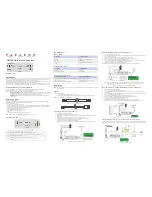
www.z-band.com/866-902-2606
3
“GigaBUD 1000” Installation Guide
General System Overview
The
Z-Band Video Distribution System
is designed to distribute the full spectrum
(54 to 860 MHz) of high quality, Analog and/or Digital Radio Frequency (RF) Video
from a CATV direct feed or a Headend (Sources) to Televisions and/or Set-top-
boxes (Receivers) in a building, campus or metropolitan area.
The Z-Band System utilizes Single-mode Fiber and/or Coaxial Cable for distribu-
tion in the Backbone and TIA 568 Certified Category 5e or better Twisted Pair
Cable for distribution in the Horizontal.
Quality Video begins with the Quality of the Video Signal and Noise Levels from
the Sources . The Z-Band System employs Intelligent Automatic Gain Control
(AGC) technology in the Backbone with the Z-Band Light Fiber Transmitter and/or
the GigaBUD Video Hub 1000 (GigaBUD 1000). In the Horizontal, the AGC is
maintained by the Z-Band Intelligent GigaBOB at each Receiver.
The AGC, in a coax based Backbone, is designed to maintain Video Signal
Integrity on a RG6 cable length of 400’ or less or a RG11 cable length of 600’ or
less; therefore, the RG6 or RG11 coax Backbone cannot exceed these limits.
If the Source Signal and Noise Levels are correct, the Z-Band AGC technology
will maintain Signal Integrity to each Receiver.
The Z-Band GigaBUD 1000 uses pins 7 & 8 of the twisted pair cable for the RF
Video and pins 4 & 5 for a return path in interactive system applications. Pins 1,
2, 3, & 6 are available for 10/100 Ethernet or other Auxiliary signals, such as
RS232 control, over the same cable (Shared Sheath) to the same destination
GigaBOB where they a broken out to separate the RF Video and Ethernet/Aux sig-
nals
The Z-Band System does not Switch, Route, Repeat, or in anyway interact with
the IP signal; we simply allow it to be sent over the same cable, to the same
destination..




































